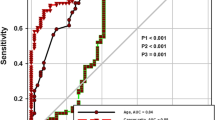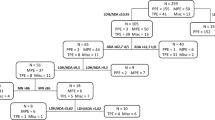Abstract
Purpose
Systemic and local inflammations have been described as relevant prognostic factors in patients with cancer. However, parameters that stand for immune activity in the pleural space have not been tested as predictors of survival in patients with malignant pleural effusion. The objective of this study was to evaluate pleural lymphocytes and Adenosine Deaminase (ADA) as predictors of survival in patients with recurrent malignant pleural effusion.
Methods
Retrospective cohort study includes patients who underwent pleurodesis for malignant pleural effusion in a tertiary center. Pleural fluid protein concentration, lactate dehydrogenase, glucose, oncotic cytology, cell count, and ADA were collected before pleurodesis and analyzed. Survival analysis was performed considering pleurodesis as time origin, and death as the event. Backwards stepwise Cox regression was used to find predictors of survival.
Results
156 patients (out of 196 potentially eligible) were included in this study. Most were female (72 %) and breast cancer was the most common underlying malignancy (53 %). Pleural fluid ADA level was stratified as low (<15 U/L), normal (15 ≤ ADA < 40), and high (≥40). Low and high ADA levels were associated with worse survival when compared to normal ADA (logrank: 0.0024). In multivariable analysis, abnormal ADA (<15 or ADA ≥ 40) and underlying malignancies different from lymphoma, lung, or breast cancer were associated with worse survival. Pleural fluid cell count and lymphocytes number and percentage did not correlate with survival.
Conclusions
Pleural fluid Adenosine Deaminase levels (<15 or ≥40 U/L) and neoplasms other than lung, breast, or lymphoma are independent predictors of worse survival in patients with malignant pleural effusion who undergo pleurodesis.


Similar content being viewed by others
References
Light RW (2007) Pleural diseases, 5th edn. Lippincott Williams & Wilkins, Baltimore
Terra RM, Kim SY, Pego-Fernandes PM, Teixeira LR, Vargas FS, Jatene FB (2011) Is silver nitrate pleurodesis for patients with malignant pleural effusion feasible and safe when performed in an outpatient setting? Ann Surg Oncol 18:50–1145
Sahn SA, Good JT Jr (1988) Pleural fluid pH in malignant effusions: diagnostic, prognostic, and therapeutic implications. Ann Intern Med 108:9–345
Rodriguez-Panadero F, Lopez-Mejias J (1989) Survival time of patients with pleural metastatic carcinoma predicted by glucose and pH studies. Chest 95:4–320
Burrows CM, Mathews C, Colt HG (2000) Predicting survival in patients with recurrent symptomatic malignant pleural effusions: an assessment of the prognostic values of physiologic, morphologic, and quality of life measures of extent of disease. Chest 117:73–78
Gonlugur TE, Gonlugur U (2008) Pleural fluid findings as prognostic factors for malignant pleural mesothelioma. J Clin Lab Anal 22:6–334
DeLong P, Carroll RG, Henry AC, Tanaka T, Ahmad S, Leibowitz MS, Sterman DH, June CH, Albelda SM, Vonderheide RH (2005) Regulatory T cells and cytokines in malignant pleural effusions secondary to mesothelioma and carcinoma. Cancer Biol Ther 4:6–342
Clive AO, Kahan BC, Hooper CE et al (2014) Predicting survival in malignant pleural effusion: development and validation of the LENT prognostic score. Thorax 69(12):104–1098
Ascierto ML, De Giorgi V, Liu Q et al (2011) An immunologic portrait of cancer. J Transl Med 9:146
Pagès F, Galon J, Dieu-Nosjean MC, Tartour E, Sautès-Fridman C, Fridman WH (2010) Immune infiltration in human tumors: a prognostic factor that should not be ignored. Oncogene 29:102–1093
Bindea G, Mlecnik B, Fridman WH, Pagès F, Galon J (2010) Natural immunity to cancer in humans. Curr Opin Immunol 22:22–215
Ye ZJ, Zhou Q, Yin W et al (2012) Differentiation and immune regulation of IL-9-producing CD4+ T cells in malignant pleural effusion. Am J Respir Crit Care Med 186:79–1168
Giusti G (1974) Adenosine deaminase. In: Bergmeyer HU (ed) Methods of enzymatic analysis. New York Academic Press, New York, pp 99–1092
Lumachi F, Mazza F, Ermani M, Chiara GB, Basso SM (2012) Talc pleurodesis as surgical palliation of patients with malignant pleural effusion. Analysis of factors affecting survival. Anticancer Res 32:4–5071
Goto M, Noguchi Y, Koyama H et al (2003) Diagnostic value of adenosine deaminase in tuberculous pleural effusion: a meta-analysis. Ann Clin Biochem 40:81–374
Yildirim H, Metintas M, Ak G, Erginel S, Alatas F, Kurt E, Metintas S, Ucgun I (2007) Increased pleural fluid adenosine deaminase levels in patients with malignant pleural effusions: a potential predictor of talc pleurodesis outcome. Lung 185:54–349
Gaga M, Papamichalis G, Bakakos P et al (2005) Tuberculous effusion: ADA activity correlates with CD4+ cell numbers in the fluid and the pleura. Respiration 72:5–160
Chen YQ, Shi HZ, Qin XJ, Mo WN, Liang XD, Huang ZX, Yang HB, Wu C (2005) CD4+ CD25+ regulatory T lymphocytes in malignant pleural effusion. Am J Respir Crit Care Med 172:9–1434
Okamoto M, Hasegawa Y, Hara T, Hashimoto N, Imaizumi K, Shimokata K, Kawabe T (2005) T-helper type 1/T-helper type 2 balance in malignant pleural effusions compared to tuberculous pleural effusions. Chest 128:5–4030
Acknowledgments
Ricardo M. Terra: Study design, data analysis, manuscript writing, and revision; Leila Antonagelo: Study design, data analysis, manuscript writing; Alessandro W. Mariani: Data collection and analysis, manuscript writing; Ricardo Lopes Moraes de Oliveira: Data collection and analysis, manuscript writing; Lisete R. Teixeira: Study design, data analysis, manuscript revision; Paulo M. Pego-Fernandes: Study design, manuscript revision.
Author information
Authors and Affiliations
Corresponding author
Ethics declarations
Conflict of interest
All Authors disclose no commercial interest or conflict regarding this manuscript.
Rights and permissions
About this article
Cite this article
Terra, R.M., Antonangelo, L., Mariani, A.W. et al. Pleural Fluid Adenosine Deaminase (ADA) Predicts Survival in Patients with Malignant Pleural Effusion. Lung 194, 681–686 (2016). https://doi.org/10.1007/s00408-016-9891-2
Received:
Accepted:
Published:
Issue Date:
DOI: https://doi.org/10.1007/s00408-016-9891-2




